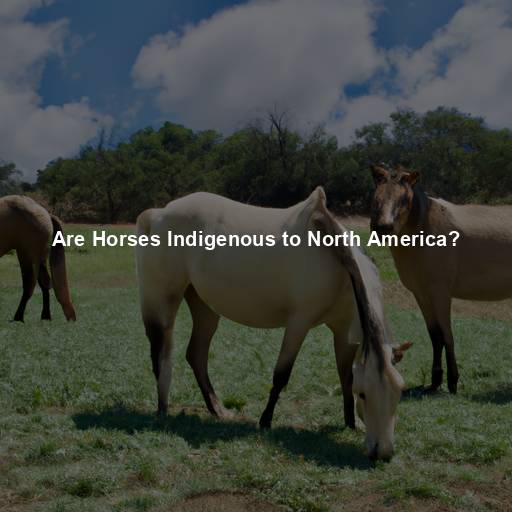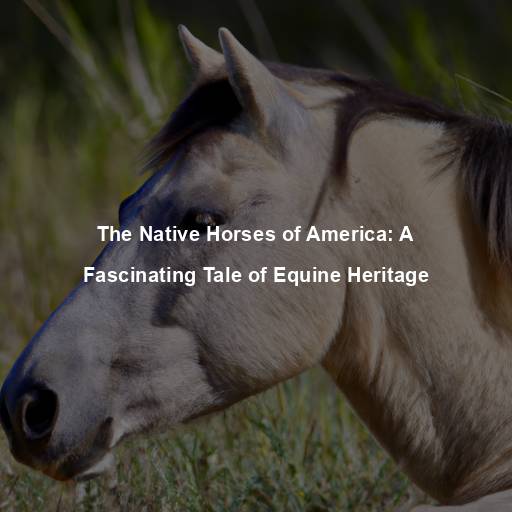Are Horses Indigenous to North America?
Last Updated on October 29, 2023 by Evan
Contents [hide]
- 1 Unraveling the Origins of Horses in North America
- 1.1 The Evolutionary Journey of Horses
- 1.2 The Great Migration
- 1.3 Horses and the Bering Land Bridge
- 1.4 The Native American Connection
- 1.5 Extinction and Reintroduction
- 1.6 The Modern-Day Horse
- 1.7 Exploring the Grey Areas
- 1.8 Tracing the Genetic Footprints
- 1.9 A New Chapter: European Arrival and the Return of Horses
- 1.10 The Native vs. Non-Native Debate
- 1.11 Embracing the Historical Tapestry
- 1.12 Cultural and Historical Significance
- 1.13 Ecological Impact of Horses
- 1.14 The Modern-Day Horse Industry
- 1.15 Conservation Efforts and Wild Horse Management
- 1.16 Looking Towards the Future
- 2 FAQs – Are Horses Indigenous to North America?
- 2.1 What is the origin of horses in North America?
- 2.2 How did horses return to North America?
- 2.3 Are there any native horse breeds in North America today?
- 2.4 How did horses impact Native American tribes?
- 2.5 Why do we often associate horses with the American West?
- 2.6 What is the current status of wild horses in North America?
Unraveling the Origins of Horses in North America
Horses are majestic creatures that have captivated our hearts and played a significant role in human history. But have you ever wondered whether horses are native to North America? The answer to this question is not as straightforward as it may seem. In this article, we will embark on a journey to explore the origins of horses and their connection to the vast lands of North America.
The Evolutionary Journey of Horses
Delving into the intricate tapestry of the equine presence in North America unveils a mesmerizing tale of evolutionary wonder. Through the eons, the noble ancestors of today’s majestic horses traversed the labyrinth of time, defying rational boundaries and adapting to the ever-changing landscapes of this vast continent. Among the enigmatic cast of characters, the curtain rises on the mysterious Eohippus, aptly nicknamed the “dawn horse,” an enchanting creature that graced our planet over 50 million years ago. In the dawn of existence, these diminutive beings, reminiscent of canine companions, wandered the bountiful forests of North America, their multi-toed feet imprinting the earth with their bewildering presence.
The Great Migration
Throughout the relentless march of time, horses have gracefully navigated the ebbs and flows of our ever-changing planet. Delving into the depths of history, around 10,000 years ago, a truly extraordinary feat took place in the Pleistocene epoch. The Bering Land Bridge, a gateway stretching from the depths of modern-day Alaska to the vast expanse of Siberia, arose, weaving together the very fabric of North America and Asia. In a bewildering twist of fate, this geological marvel became a conduit for countless species, like the majestic horse, to embark on a perplexing journey between these two continents.
Horses and the Bering Land Bridge
Imagine the astonishing odyssey that unfolded as horses bravely navigated the formidable Bering Land Bridge, embarking on a momentous expedition from Asia to the untouched wilderness of North America. These intrepid equines, known to us today as the remarkable “Equus genus,” not only triumphantly crossed this perilous divide but also triumphed in establishing their enduring legacy in the vast and enigmatic landscapes of the New World. As the eons rolled by, horses embraced the challenges of their newfound realms, ingeniously adapting to the kaleidoscope of ecosystems and unpredictable climates that awaited them, ensuring their prosperous and resilient existence.
The Native American Connection
The entrance of majestic horses into the vast landscapes of North America stirred an undeniable wave of wonder and transformation among the indigenous population. These remarkable creatures swiftly ingrained themselves into the tapestry of Native American culture, bringing about an unparalleled metamorphosis. With their graceful stride, horses revolutionized the Native Americans’ modes of transportation, granting them newfound mobility and hastening their journeys across boundless terrains. Beyond the realm of travel, these magnificent beings reshaped hunting techniques and warfare strategies, forever etching their hoofprints in the legacy of the Plains Indians, as the rhythms of their nomadic lifestyles amplified with a profound sense of unity and kinship with their equine companions.
Extinction and Reintroduction
Despite their flourishing presence in North America, horses faced a tumultuous fate. Towards the end of the last Ice Age, approximately 11,000 years ago, a mass extinction event occurred, wiping out numerous large mammal species, including horses. The reasons for this extinction are still a subject of scientific debate. However, it is important to note that horses were absent from North America for thousands of years following this catastrophic event.
The shores of North America bore witness to the revival of equine companionship in the 15th century, courtesy of European explorers and settlers. The arrival of these majestic creatures, distant relatives of the domesticated Old World horses, marked a turning point in the annals of the New World’s narrative. Their reintroduction breathed new life into the pages of history, intertwining the destinies of humans and horses in an intricate dance of resilience and legacy.
The Modern-Day Horse
Venturing across the vast North American terrain today, one can scarcely escape the captivating allure of the equine companions that grace its open plains. Nevertheless, one must tread the path of discernment to unravel the intricate tapestry that intertwines the indigenous, untamed horses with their conquered, domestic counterparts. Marvel at the majestic Mustangs, proud descendants of the noble steeds brought forth by Europeans ages ago, for they have evolved into an enduring emblem of the untamed American frontier that bewitches the soul.
Exploring the Grey Areas
The captivating tale of horses in North America unfolds with perplexing intricacy. Although their origins do not align with strict notions of nativeness, their transformative influence on the continent cannot be dismissed. The concept of nativeness itself becomes enigmatic when we embrace the complexity of ecosystems’ interwoven tapestry. To truly comprehend this narrative, we must delve into the fascinating web of species connections, transcending rigid geographical borders.
Tracing the Genetic Footprints
Genetic studies have provided valuable insights into the ancestry of horses in North America. By analyzing ancient DNA and comparing it with modern horse populations, scientists have unraveled the intricate genetic puzzle of these majestic creatures. The findings suggest that while horses originated in North America, they disappeared from the continent for thousands of years before making a comeback through human intervention.
Ancient Horse DNA
The study of ancient horse DNA has allowed scientists to piece together the puzzle of their origins. By extracting and analyzing genetic material from fossilized remains, researchers have been able to trace the lineage of horses back to their earliest ancestors. These ancient DNA studies have revealed a complex history of migration, extinction, and reintroduction.
The Origins of North American Horses
Unearthing the secrets of our ancient past, scientific research unveils a captivating narrative that traces the origins of horses back to the unexplored realms of North America. Delving into the vaults of time, fossil records serve as portals to a bygone era, unveiling a myriad of equine species, including the legendary three-toed horses. Majestic and resilient, these native creatures danced freely amidst the sprawling grasslands and verdant forests, their hooves pounding a rhythm that echoed through the epochs. Undeniably, the North American continent played host to a captivating saga of evolution and survival, where these magnificent beings flourished and adapted over countless millennia in the absence of human presence.
The Pleistocene Extinction
Thousands of years in the past, something truly astonishing occurred – the Pleistocene extinction. This enigmatic event, shrouded in mystery even today, cast a shadow of doubt over the fate of numerous majestic creatures, including the indigenous horses that once grazed the North American plains. Scientists are entangled in a puzzle as they grapple with the bewildering array of hypotheses, from the unforgiving clutches of climate change to the controversial role of early humans hunting these magnificent beasts. Still, one thing remains certain: the absence of these majestic equines lingered over the land, teasing us with its whispers of perplexity.
A New Chapter: European Arrival and the Return of Horses
European Exploration and Colonization
The landscape of the horse kingdom in North America underwent a dramatic transformation during the 15th century. It was a time of great upheaval as European explorers and settlers ventured across the vast oceans, unknowingly carrying with them a remarkable gift – the domesticated horses of the Old World. These majestic creatures, whose bloodline traced back to the ancient breeds of Eurasia, breathed new life into the equine realm of North America, rekindling a connection that had long been lost.
The Impact of Horses on Native American Cultures
The arrival of horses on American soil by European colonizers stirred up an unforeseen whirlwind, leaving Native American cultures marvelously perplexed. Among these, the Plains Indians found themselves entranced by the art of horsemanship, effortlessly incorporating these majestic creatures into their very existence. The nomadic tribes of the Great Plains embraced this enigmatic transformation, becoming adept riders and revolutionizing their hunting and warfare strategies. With each rhythmic gallop, the horse became an emblem of strength, liberation, and an intertwined tapestry of existence for countless indigenous communities.
Mustangs: The Wild Horses of North America
The untamed spirit of the frontier finds its animate muse in the remarkable presence of wild horses in North America. With their origins intertwined with the legacy of European horse reintroduction, the descendants of the domesticated horses brought by Europeans have evolved into the magnificent mustangs that freely roam the rugged terrains, most notably across the vast landscapes of the American West. The perplexing beauty lies in their ability to adapt and survive amidst unforgiving surroundings, thus cementing their status as an iconic symbol of resilience and untamed grandeur.
The Native vs. Non-Native Debate
Defining “Indigenous”
The true origins of horses in North America remain enigmatic, shrouded in a hazy mist of uncertainty. Scholars ponder and debate whether these majestic creatures can truly be labeled as indigenous to the land. The very definition of “indigenous” becomes tangled in a perplexing web, as horses originated in this vast continent, yet their story takes an intricate turn with their extinction and subsequent reintroduction. The enigma of their indigeneity stands as an intricate tapestry waiting to be unraveled.
The Complexity of Ecological Relationships
Understanding the concept of nativeness requires a broader perspective on ecological relationships. Ecosystems are complex networks of interdependent species, and defining a species’ “nativeness” based solely on geographic origins may overlook the intricate ecological roles they play. Horses, despite their complex history, have become integral components of North American ecosystems, shaping vegetation, providing habitats for other species, and even influencing fire regimes.
Embracing the Historical Tapestry
Delving into the enigmatic origins of horses in North America reveals a captivating narrative that transcends conventional notions of nativity. While they may not be indigenous per se, horses possess an ancient lineage that intertwines with the continent’s fabric, prompting a thought-provoking examination of their cultural impact. From shaping landscapes to inspiring human creativity, these majestic creatures have become emblematic of the intricate historical mosaic that intertwines the destinies of both animals and humans. Therefore, the sight of a wild mustang herd gracefully coursing through the plains serves as a powerful testament to the incessantly evolving saga of horses in North America.
Cultural and Historical Significance
Horses have played a significant role in the cultural and historical fabric of North America. From the early interactions between Native Americans and European settlers to the present-day equestrian traditions, horses have left an indelible mark on the continent’s heritage.
The Horse and Native American Tribes
The reintroduction of horses by Europeans had a transformative effect on Native American tribes. Horses revolutionized the way of life for many tribes, enabling them to hunt more efficiently, expand their territories, and engage in warfare with newfound mobility. The horse became a symbol of power and prestige within Native American society, forever altering their cultural practices and traditions.
The Wild West and Cowboy Culture
The image of the American cowboy, galloping across the open range on horseback, has become an enduring symbol of the Wild West. Horses played a pivotal role in the development of cowboy culture, enabling ranchers to manage vast herds of cattle, participate in rodeos, and undertake long cattle drives. The cowboy’s bond with his horse epitomizes the deep connection between humans and these magnificent animals.
Ecological Impact of Horses
Over the centuries, these majestic creatures have left an indelible mark on the tapestry of North American culture, weaving their way through the hearts and minds of its people. But beyond their cultural significance, horses have quietly played a pivotal role in reshaping the very fabric of the continent’s ecosystems. Their hooves pounding on the ground, their grazing habits shaping the vegetation, horses have left a mesmerizing, yet perplexing ecological legacy that continues to captivate both scientists and nature enthusiasts alike. Their burst of energy, both physical and metaphorical, has left a trail of questions that unravel the interconnectedness between these magnificent creatures and the landscapes they call home.
Grazing and Vegetation Dynamics
Horses, those remarkable herbivores, possess an intriguing ability to leave a lasting impact on the ever-changing dynamics of vegetation. Their voracious appetite for grazing has proven to be a powerful force in shaping the intricate tapestry of plant communities, altering the very essence of species composition and distribution. In the vast realms where wild horses hold sway, their enigmatic foraging behavior has the potential to maintain open grasslands with captivating finesse. However, one must tread carefully, for their insatiable grazing patterns can also unleash havoc, propelling the delicate balance towards the treacherous path of overgrazing and the subsequent decline of fragile ecosystems.
Habitat Creation and Conservation
Horses have the ability to modify their environment, creating habitats for other species. Their trampling and grazing behaviors can create open areas that benefit certain plant species and provide habitat for various small mammals, birds, and insects. In this way, horses indirectly contribute to biodiversity and conservation efforts.
The Modern-Day Horse Industry
In the mosaic of our rapidly evolving world, horses remain steadfast, defying the whims of time and carving their indelible presence. Amidst the whirlwind of industries that dance in harmony with our modern society, we find the equine realm triumphantly flourishing across diverse sectors. From the thunderous echoes of hooves on racetracks to the serene elegance of equestrian sports, the vitality of these majestic creatures captivates and beguiles, entwining seamlessly with our ever-shifting fabric.
Recreational Riding and Equestrian Sports
There’s a certain allure to the art of horseback riding that continues to enchant people from all walks of life. The harmonious connection between humans and horses ignites a sense of wonder and awe, as these majestic beings carry us on their backs, guiding us through the untamed beauty of nature. And let us not forget the thrilling world of equestrian sports, where grace meets power in a mesmerizing display of talent and finesse. From the elegance of show jumping to the precision of dressage and the adrenaline-fueled excitement of rodeo events, these captivating spectacles never fail to leave audiences spellbound, their hearts galloping along with the riders and their equine companions.
Therapy and Assistance Programs
Horses also play a vital role in therapeutic settings. Equine-assisted therapy programs have been developed to help individuals with physical, emotional, and cognitive challenges. Interacting with horses can provide therapeutic benefits, promoting emotional well-being, self-confidence, and physical rehabilitation.
Conservation Efforts and Wild Horse Management
Balancing Conservation and Population Control
The presence of wild horse populations in North America has led to ongoing debates and management challenges. While wild horses are cherished for their beauty and cultural significance, their increasing numbers can strain ecosystems, leading to overgrazing and habitat degradation. Balancing conservation efforts with population control measures is essential to ensure the sustainability of both wild horse populations and the ecosystems they inhabit.
Adoption and Sanctuary Programs
In order to tackle the complex issues surrounding the management of wild horses, numerous initiatives have emerged, offering both adoption and sanctuary solutions. These programs strive to secure a future for these magnificent creatures that have been captured or relocated, granting them the opportunity to receive the care, training, and protection they deserve. Through adoption programs, compassionate individuals can open their hearts and homes to these wild horses, giving them a shot at a new life within the comforts of domesticity.
Looking Towards the Future
In the tapestry of the North American landscape, the saga of horses unfurls in a tapestry woven with threads of evolution, cultural metamorphosis, and ecological resonance. These enigmatic beings, their presence both ethereal and steadfast, beckon us to embark on a prodigious quest of comprehension and exploration. As we stride towards an uncertain future, it becomes imperative to delve deeper into the intricate web of connections between horses, humanity, and the natural world that cradles us all. Embracing stewardship with a resolute sense of purpose, nurturing the essence of conservation, and savoring the intrinsic harmony that binds us to these majestic beings, we illuminate a path to a coexistence that transcends time and enriches generations yet to emerge.
As you find yourself in the presence of a majestic horse, whether amidst the serene beauty of a meadow or amidst the electrifying energy of a racetrack, allow yourself a quiet pause to delve into the depths of their captivating existence. With every stride, these magnificent creatures hold within them a profound connection to the past, a tapestry woven from the threads of history, culture, and ecological importance. From the ancient bond with humans to their role in shaping the delicate balance of ecosystems, there is a wealth of knowledge to be unraveled and appreciated. So, next time you cross paths with a horse, let yourself be enveloped in the enigmatic allure that they exude, for within their very essence lies a world of mystery and intrigue waiting to be explored.
FAQs – Are Horses Indigenous to North America?
What is the origin of horses in North America?
Horses, as we know them today, are not indigenous to North America. The ancestors of modern horses actually originated and evolved in North America millions of years ago. However, they became extinct on this continent around 10,000 years ago due to various factors, including climate change and overhunting by early humans.
How did horses return to North America?
Horses were reintroduced to North America by European explorers and settlers during the 15th and 16th centuries. Spanish conquistadors and other Europeans brought horses with them when they arrived in the New World. These horses rapidly spread throughout the continent and eventually became an integral part of Native American cultures and the development of the American West.
Are there any native horse breeds in North America today?
Ah, the captivating world of North American horse breeds, a tapestry woven with historical intricacies and captivating tales. It is crucial to tread lightly along the path of discovery, for while these majestic creatures roam the vast expanse of the continent, they are not native to its soil. Instead, they charm us as the descendants of equine pioneers, carried across the sea by European explorers during the epoch of colonization. Within this mosaic of equine heritage, we witness the emergence of remarkable breeds such as the American Quarter Horse, the resplendent Appaloosa, and the untamed Mustang, each finding their place amidst the diverse landscapes of the American West.
How did horses impact Native American tribes?
The arrival of horses in North America sent shockwaves through the Native American tribes, transforming their way of life in ways that left their tongues tied in perplexity. With the sudden surge of equine companions, tribes found themselves immersed in a whirlwind of possibilities, propelling their cultures into realms of boundless exploration. As if touched by an enigmatic force, these majestic creatures granted the tribes unwavering mobility, a burst of hunting prowess, and an intricate web of trade connections that defied comprehension. As they galloped into battle, horses became a mystical secret weapon, bestowing upon their riders an unfathomable advantage over their adversaries.
Why do we often associate horses with the American West?
The fascinating link between horses and the American West is steeped in a captivating blend of historical happenstance and vivid artistic portrayals. As European colonization swept across North America, the omnipresence of majestic horses mirrored the expanding frontiers. It is amidst this untamed backdrop that the indelible image of cowboys skillfully maneuvering on horseback, tirelessly herding cattle, has seeped into numerous Western tales, motion pictures, and exquisite artwork. Bound together by the compelling narratives of frontier exploration, vast panoramic vistas, and a profound yearning for boundless liberty, horses have become an emblematic symbol of the enigmatic American West.
What is the current status of wild horses in North America?
In our modern era, the vast expanse of North America has become a sanctuary for awe-inspiring herds of untamed equines, particularly in the expansive western region of the United States. These majestic creatures, affectionately known as Mustangs, trace their lineage back to once-domesticated horses who embraced their wild nature once more following the arrival of European settlers. The intricate task of managing and safeguarding these untamed horses poses a myriad of complexities, as it necessitates a delicate balance of environmental preservation, competing land utilization, and the overall well-being of these captivating creatures. Committed government bodies, alongside a tapestry of dedicated organizations, relentlessly strive to navigate these challenging realms and guarantee the enduring welfare of these untethered equine populations.







